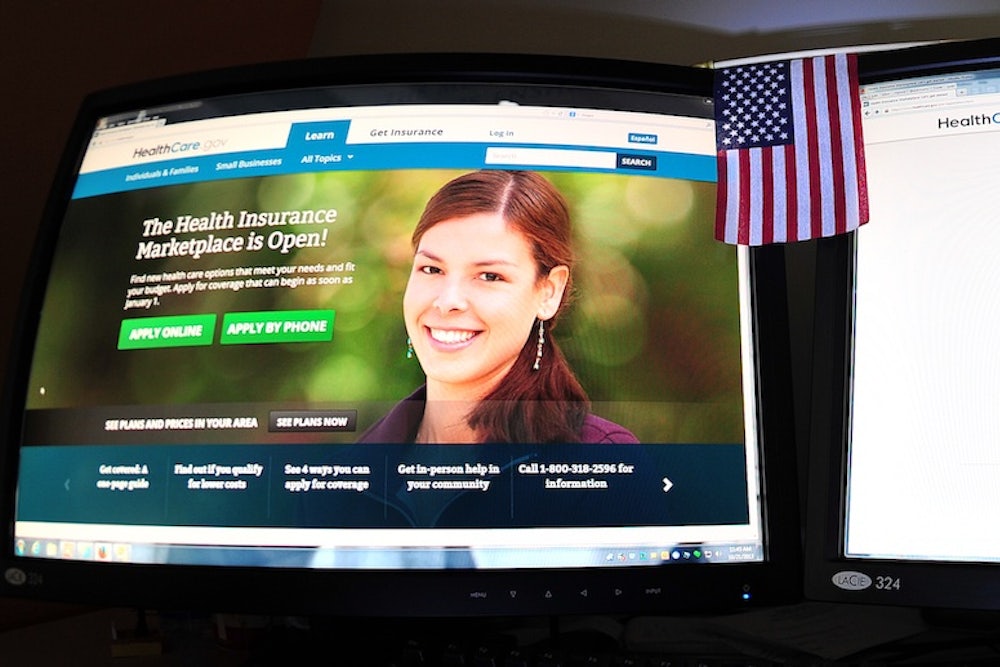One issue that came up in Thursday’s House hearings on healthcare.gov is the government’s decision, in the middle of September, to require that people create new accounts before browsing insurance plans. It's possible (although not certain) that this design decision contributed to the site’s problems, particularly in the early days. Account creation is a particularly complex process, one that has given the federally run website fits. Particularly in the first few days, people trying to use healthcare.gov frequently got stuck on the first few screens and never made it to subsequent steps in the process—like applying for financial aid and picking plans.
This decision has become a source of great controversy, with conservatives arguing it was a last-minute effort to deceive the public. At the hearings, Congressman Cory Gardner from Colorado accused the Administration of trying “to hide the real cost of Obamacare to the American people.” Morgan Griffith, a Republican from Virginia, said it was a “political decision.” Based on the tone and redundancy of the questions, this is about to become a full-blown conspiracy theory on the right. Before that happens, let’s clear up a few misconceptions.
Under Obamacare, the pricing of individual insurance policies in the new marketplaces is actually a two-step process. First the insurer sets a "sticker price." That’s the actual, total cost of the policy—the money the insurer will recieve in exchange for providing health benefits. But it’s not what most individuals and families will actually pay directly. By design, Obamacare discounts those prices for individuals and families by offering federal tax credits. That way, even people at very low incomes can afford to buy the policies.
When designing the system, officials faced a choice. What price should consumers see initially—the sticker price or the discounted price? The difference in some cases would be huge. Imagine a working mother, with two kids, living in Missouri and pulling down an income of $35,000 a year. Based on the Kaiser Family Foundation subsidy calculator, the sticker price for family’s coverage would be about $4,200 a year. But the subsidized cost would be just $2,300.
If this working mom saw the sticker price, she might see that $4,200 annual premium, figure coverage was too expensive, and give up—never learning she was eligible for assistance that would cut the price nearly in half. Based on conversations with sources in and out of government, that's why officials decided to make sure consumers saw the discounted price first—because the officials wanted to make sure consumers saw the prices they would actually pay.
Conservatives think this is a form of deception, because people won't realize how much Obamacare really costs the government and, by extension, the taxpayers. That doesn’t make much sense to me. It's not like most people are going to see the insurance prices and conclude, based on that number, how many billions of dollars the program really costs to run. "Gee, my family premium is $5,000 a year—I bet that means the ten-year outlays through 2019 are actually closer to $1 trillion than $800 billion. Hmmm...."
OK, but then why did officials force people to register for accounts first? According to sources in and outside of government, that has nothing to do with trying to hide prices and everything to do with technical issues. As administration officials now confirm, the original plans called for an "anonymous browsing" or "window shopping" option. Officials nixed that option for one reason and one reason only: It wasn't ready by the middle of September. In the frantic rush to streamline online operations, they figured they'd leave completion of that task until later. (A clunkier version of such a browsing option now exists and, according to administraiton officials, it's also possible to see the unsubsidized prices.)
One more thing: Several states have well-functioning websites. These states generally don’t require people to set up accounts right away. They allow people to window shop, just like federal officials intended for healthcare.gov, and that may be one reason they are working better. But even those systems ask visitors to enter basic income information, so that they see subsidized prices, not sticker prices.
So if there was a plot here, it involved not just federal officials but also state officials. And its goal was to help more people get insurance.
There are very serious questions about the way development of healthcare.gov was managed—more serious than many of the law's supporters seem to realize. Unless I'm missing something, this shouldn't be one of them.
Update: A related issue (but not the same) is that the new browsing function the administration added gives misleading figures for the prices, by estimating prices for everybody ages 27 to 49 based on a 27-year-old. That's genuinely problematic—a 49-year-old pays considerably more than a 27-year-old—and should be fixed.
